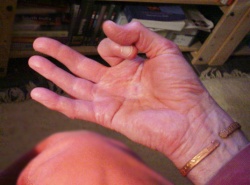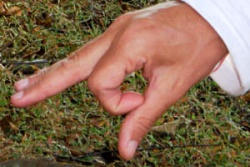Jnana mudra
Jñāna Mudrā
The Jñāna mudrā ("mudrā of knowledge") is done by touching the tips of the thumb and the index together, forming a circle, and the hand is held with the palm inward toward the heart,
Many of us are familiar with Jnana mudra – thumb and index finger forming a circle with the other three fingers extended, the hands usually resting on the thighs or in the lap. It is sometimes called the Mudra of Wisdom. Recently when I was talking to a group and explaining the aim of yoga – to unite body, mind and soul, I spontaneously held up my hand in that position with the palm facing towards me. The index finger was held down by the thumb, and the other three fingers extending upwards.
In Jnana mudra the index finger – which in Hindu thought can be seen as representing the ego, is held down and subjugated by the power of the thumb representing the Universal spirit. Another way of looking at it is to see the ego being burned in the power of the fire of Agni, the deity associated with the thumb.
On this occasion however it was the three remaining fingers that were significant. As I looked at my hand I realised that my `body` finger was my little finger, the smallest of the three – and the least important perhaps. My `mind` was my ring finger – next in size and the one we think is so important we even girdle it with rings and jewels, we value it so highly. However the biggest finger of all was my middle finger representing my soul and reaching the highest of all towards the sky and heaven.
Symbols are only of value when they are meaningful. Jnana Mudra seen from a different angle taught me the realisation of the relative values of body, mind and soul. Sit in any meditative asana. Fold the index fingers of both hands so that the tips touch the inside root of their corresponding thumbs. Straighten the other 3 fingers and separate them slightly. Place the hands on the knees, with the palms downwards. The 3 unbent fingers and the thumb of each hand should point downwards towards the floor in front of the knees. Relax your arms and hands. Now prepare yourself for meditational practice.
Alternative of Jnana Mudra
Jnana mudra is often performed with the tip of the thumb and the index finger in touch with each other. In other words, the thumb and the index finger form a circle. This variation is equally as good as the basic position we have just described.
Symbolic significance of Jnana Mudra
This mudra is not only very comfortable for meditative practices, it also has various symbolic meanings. The following is the most common: the straight fingers, small, ring and middle, represent the three categories of nature. That is, nature is divided into three arbitrary aspects: tamas (inertia, laziness, darkness, ignorance, etc.), rajas (action, passion, movement) and sattwa (understanding, purity).
These three states have to be transcended one after the other, in order to pass from darkness into light and from ignorance to knowledge. The bent index finger represents the individual manifestation of consciousness (jivatma).
The thumb symbolizes the all pervading consciousness or reality. The individual (index finger) is bowing down to supreme consciousness (thumb) and acknowledging its unsurpassed power. Yet at the same time the index finger and the thumb touch each other, which shows that though they seem separate, in fact the individual being is one with the supreme. It symbolizes yoga at its culmination.

